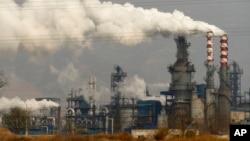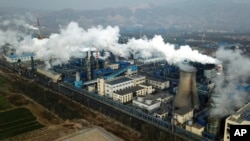Data monitoring and human dietary changes are among ways China could slash its methane emissions, experts have told VOA.
China emitted 58.3 metric tons of methane last year, more than any other country, according to the Global Methane Tracker. China has not signed the Global Methane Pledge, first initiated in 2021 at COP26 in Glasgow to slash 30% of world methane emissions from 2020 levels by 2025. Methane is a greenhouse gas responsible for one-fourth of the world’s warming and is 80 times more potent at warming the atmosphere than carbon dioxide.
Nearly half of China’s methane comes from the power sector, followed by agriculture, the country’s most recent data, from 2014, shows.
Chinese climate envoy Xie Zhenhua told the COP27 climate talks in Egypt that China has drafted an action plan to rein in methane emissions, focusing on oil and gas, agriculture and urban waste management. He said China would have to improve its quantifying methane emissions, echoing comments from Marcelo Mena, CEO of the NGO Global Methane Hub and former Chilean environment minister.
“The [methane] data is sometimes from very basic literature reviews and does not necessarily reconcile with observations,” Mena told VOA by phone. “If that information is not complete, it will be difficult to really design mitigation options that are credible.”
Mena suggested using remote sensing to measure emissions from above and from surface level. An article this year published by the Munich-based European Geosciences Union, says the authors’ estimate of China’s methane emissions is 21% higher than China’s official data.
As the United States and China resumed climate discussions at COP27, scientific cooperation on monitoring methane emissions could be a key area, according to Scot Miller, assistant professor of environmental health and engineering at Johns Hopkins University.
“The technology for monitoring missions from space ... is still being improved upon and developed upon,” Miller told VOA in a video call. “One real area for collaboration is to put scientific expertise together to figure out how we can make the most of these satellite observations and how we can continue to help advance this technology by leaps and bounds.”
Miller’s research found that China’s coal mine methane emissions went up each year from 2010 to 2015, rendering their mitigation policies during that period ineffective. As over half of China’s electricity still comes from burning coal, its coal-related methane emissions remain high, equivalent to the carbon emissions from the international shipping industry.
An energy crisis last year drove the nation to boost coal supply and mine a record 4,070 metric tons, which is estimated to emit 2.5 million metric tons of methane into the atmosphere, a report from Global Energy Monitor said.
Abandoned mines are another coal methane source.
“We don’t know how much methane is coming from those mines,” Miller said.
Methane emissions from abandoned mines are expected to grow more quickly than those from established mines, according to a 2021 study. Currently, the most effective way to seal coal mines and prevent methane from leaking is to slowly flood them, but local media report that China does not have a mechanism or policies for handling abandoned mines.
Aiming to switch to cleaner energy, China has been expanding its use of natural gas as a coal substitute, but a recent study showed that the reduced carbon emissions could be offset by methane leakage from such use.
Agriculture is the second-largest Chinese source of methane emissions – from animal digestion, excretion and aquatic plants. A report from the Changing Markets Foundation and the Institute of Agriculture and Trade Policy released at COP27 said that 15 dairy and meat companies are together responsible for more methane emissions than Russia.
“China, as the world’s biggest meat producer and consumer, has a critically important role to play,” Ben Lilliston, the institute’s director of rural and climate strategies told VOA by email.
To reduce methane emissions, “Xie suggested using biogas, so building biogas plants to deal with manure from these huge agriculture operations,” Nusa Urbancic, campaigns director at the Changing Markets Foundation, told VOA by video call.
“The concern has been that it might incentivize further intensification of this type of operations. If you build huge biogas plants, you need more manure. It might lock you into this industrial animal production system, which we believe should actually be abolished,” she said.
Instead of using biogas, Urbancic said human dietary changes can bring about food production reform that could eventually slash methane emissions.
“We should move away from high carbon intensive meat and dairy products and move towards healthier diets. This is where China actually has an opportunity, right? It can also offer more innovation in terms of having more sustainable production systems where you can grow protein from beans and lentils and other plant-based materials.”
China’s commitment is needed. “It will be very difficult to reach the 30% by 2030 goal outlined in the Global Methane Pledge, without China’s active participation,” said Lillisten.
Published with support of Climate Tracker's Climate Justice Fellowship.










